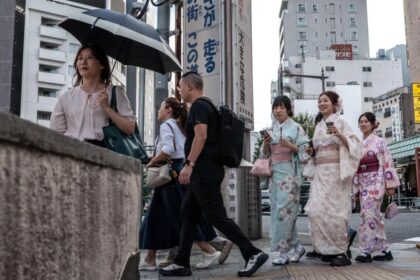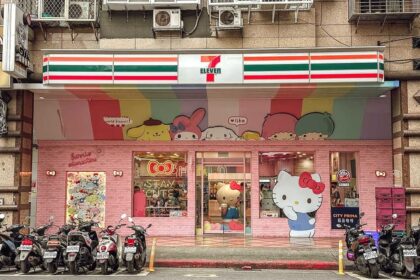The Night Kyoto Burns Bright: Gozan Okuribi’s Enduring Magic
Every August 16, as dusk settles over Kyoto, the ancient city’s skyline is transformed by a spectacle of fire and tradition. Five mountains encircling the city burst into flame, each illuminated with giant characters and symbols visible for miles. This is Gozan Okuribi—also known as the Daimonji Festival—a ritual that marks the emotional finale of the Obon season, when Japanese families honor and bid farewell to the spirits of their ancestors.
On a recent Saturday night, more than 22,000 people gathered across Kyoto to witness this luminous event. From riverside banks to rooftops and bridges, locals and visitors alike watched as the mountains glowed with meaning, history, and reverence. For many, it’s a moment of beauty; for others, a deeply personal act of remembrance.
What Is Gozan Okuribi? The Ritual and Its Meaning
Gozan Okuribi (五山送り火) literally means “Five Mountain Send-Off Fires.” The festival is the culmination of Obon, a Buddhist holiday when it’s believed that the spirits of deceased relatives return to visit the living. Obon is celebrated across Japan, but Kyoto’s send-off is unique: rather than lanterns or small fires, the city lights up entire mountainsides with enormous bonfires shaped into kanji characters and symbols.
According to tradition, these fires guide the ancestral spirits back to the spirit world after their brief homecoming. The ritual is both a farewell and a prayer for protection, health, and good fortune for those left behind. As one Kyoto resident explained,
“Both flame lighters and rooftop gatherers alike send their thoughts to their ancestors, as they watch the fires burning bright with awe and reverence.”
The festival’s origins are shrouded in mystery, with some sources tracing it back to the 13th century and others to the Muromachi period (1336–1573). What’s certain is that the event has been passed down through generations, with local families and preservation societies responsible for maintaining the tradition and lighting the fires each year.
The Five Fires: Characters and Symbols
Each of the five bonfires is carefully arranged to form a specific character or shape, each with its own meaning:
- Daimonji (大): The most famous, meaning “large” or “great,” is lit on Mount Daimonji (Nyoigatake) at 8:00 p.m.
- Myo-Ho (妙・法): Meaning “wondrous dharma” (the law of Buddha), these two characters are lit on two adjacent mountains at 8:05 p.m.
- Funagata (舟形): A boat-shaped fire on Mount Funa at 8:10 p.m.
- Hidari Daimonji (左大文字): Another “large” character, this time on the left, at 8:15 p.m.
- Toriigata (鳥居形): Shaped like a Shinto shrine gate (torii), this fire is lit at 8:20 p.m.
The fires are lit in sequence, each burning for about 30 minutes. By 8:30 p.m., all five are visible, creating a ring of fire around the city.
Rituals, Superstitions, and Community Involvement
Preparation for Gozan Okuribi is a community effort. Volunteers and committee members spend months gathering wood, preparing the fire beds, and collecting gomagi—wooden prayer sticks on which people write their wishes, illnesses, or the names of ancestors. These gomagi are burned with the bonfires, their prayers believed to rise to the heavens with the smoke.
There are also superstitions associated with the fires. Some believe that drinking sake or water that reflects the burning bonfires will protect against illness. Others visit temples to write prayers on gomagi, hoping for blessings or healing.
For many Kyoto residents, the festival is a cherished family tradition. As one father attending with his young daughter shared,
“I have been unable to visit my family grave, so I am glad that I could come to the event with my daughter.”
The Festival Experience: Where and How to Watch
Kyoto’s geography makes Gozan Okuribi a citywide event. The fires can be seen from numerous vantage points, and the city’s residents have long gathered in favorite spots to watch the spectacle. In the past, families would climb onto their rooftops, but today, with taller buildings and fewer traditional homes, crowds gather along the Kamogawa River, on bridges, and in parks. Some of the best viewing locations include:
- Kamogawa River banks
- Kyoto University rooftops
- Kitayama Street and Takanobashi Bridge
- Hirosawa Pond in Arashiyama (where floating lanterns are also released)
- Kyoto Station Building Skyway (advance tickets required)
- Kyoto Tower (limited spaces)
Special rooftop events, such as those at textile centers or hotels, offer premium views for a select few. In recent years, the Kyoto City Tourism Association has even introduced exclusive experiences for foreign tourists, including guided tours of the fire beds and private viewing parties—though these come at a steep price, with some packages costing over $1,500 per person.
Atmosphere and Emotions: A Night of Reflection
The mood during Gozan Okuribi is a blend of excitement and solemnity. Young couples and tourists snap photos and marvel at the glowing mountains, while older locals watch quietly, some moved to tears as they remember loved ones. As one eyewitness described,
“I was more interested in getting good photographs, but there is more to Gozan no Okuribi. Beyond showing respect, gratitude, and love in ancestral worship, this ritual puts one through the parting with loved ones again. Somehow, there is beauty and resilience in people who can go through these painful partings over and over again.”
Gozan Okuribi in the Modern Era: Challenges and Adaptations
Like many traditional festivals, Gozan Okuribi has faced challenges in recent years. The COVID-19 pandemic forced organizers to scale back the event in 2020 and 2021, lighting only a handful of fire beds on each mountain to prevent crowds and protect volunteers. The shapes of the characters and symbols were incomplete, and for the first time, the ritual was live-streamed so people could participate from home.
In 2022, the festival returned to its full form, with all fire beds lit and the characters burning brightly once again. Organizers expressed relief and pride at being able to pass down the traditional techniques to future generations. As Yoshio Okamoto, head of the festival’s organizing federation, said,
“It is truly gratifying that traditional techniques on how to pile up the firewood can be passed down to future generations.”
Despite modernization and commercialization—such as premium viewing packages and festival-themed products—the heart of Gozan Okuribi remains unchanged: it is a night for Kyoto to remember, reflect, and reconnect with its past.
Tourism, Tradition, and Controversy
The festival’s growing popularity among tourists has brought both opportunities and challenges. While exclusive experiences offer visitors a deeper understanding of the ritual, some local religious leaders have raised concerns about the commercialization of what is, at its core, a sacred event. Organizers have responded by ensuring that food and alcohol are not consumed during the viewing itself and by consulting with preservation societies to maintain the festival’s dignity.
For visitors, Gozan Okuribi is often the highlight of a summer trip to Kyoto, alongside other seasonal events like fireworks, tea ceremonies, and riverside dining. The festival is also reflected in local culture, inspiring everything from sweets and souvenirs to tofu shaped like the festival’s iconic symbols.
Kyoto’s Gozan Okuribi: A Living Tradition
What makes Gozan Okuribi so enduring is its ability to bridge past and present, the sacred and the communal. The fires are more than just a visual spectacle—they are a living tradition, connecting generations through shared memory and ritual. As the flames rise each August, they carry with them the hopes, prayers, and gratitude of a city that has cherished this night for centuries.
Whether you are a Kyoto local, a returning visitor, or a first-time observer, witnessing Gozan Okuribi is to experience the soul of Japan’s ancient capital—where history, spirituality, and community burn brightly together.
In Summary
- Gozan Okuribi is Kyoto’s iconic bonfire festival held every August 16 to mark the end of Obon, sending off ancestral spirits with five giant fires on surrounding mountains.
- The fires form kanji characters and symbols: two “large” (dai), “wondrous dharma” (myo-ho), a boat, and a shrine gate (torii), each with deep spiritual meaning.
- The festival draws tens of thousands of spectators, blending solemn remembrance with communal celebration.
- Preparation involves community volunteers, ritual prayer sticks (gomagi), and centuries-old techniques passed down through generations.
- The event was scaled back during the pandemic but has since returned to its full form, with new tourism initiatives and ongoing debates about commercialization.
- Gozan Okuribi remains a powerful symbol of Kyoto’s cultural heritage, offering a moving experience for locals and visitors alike.












